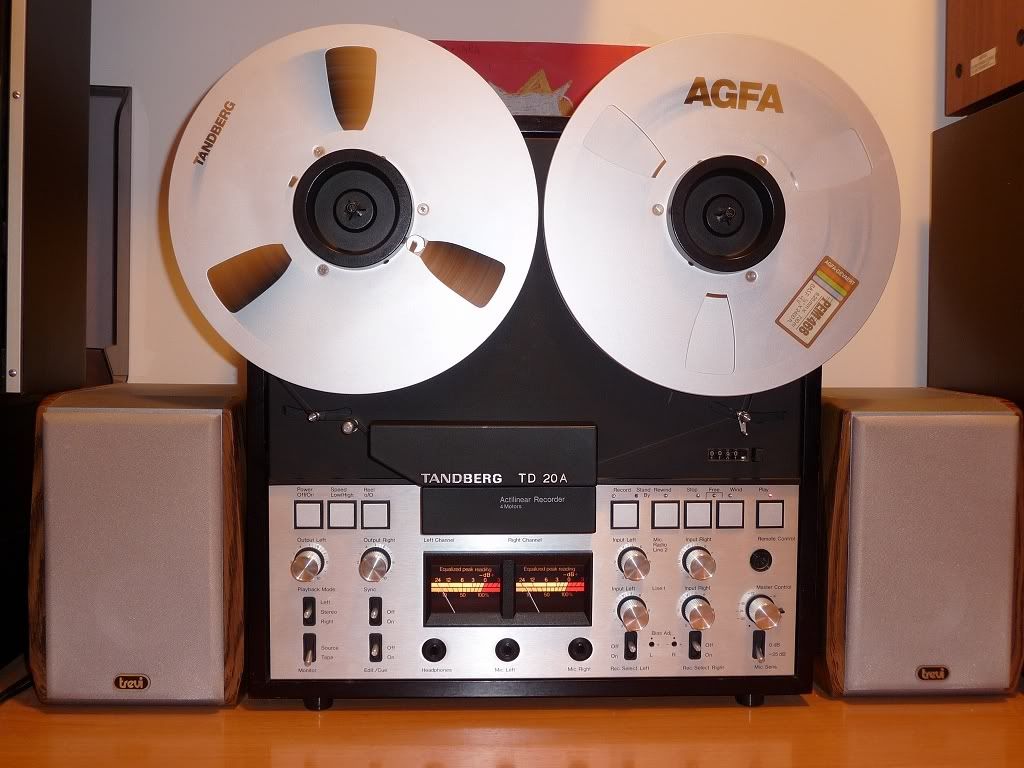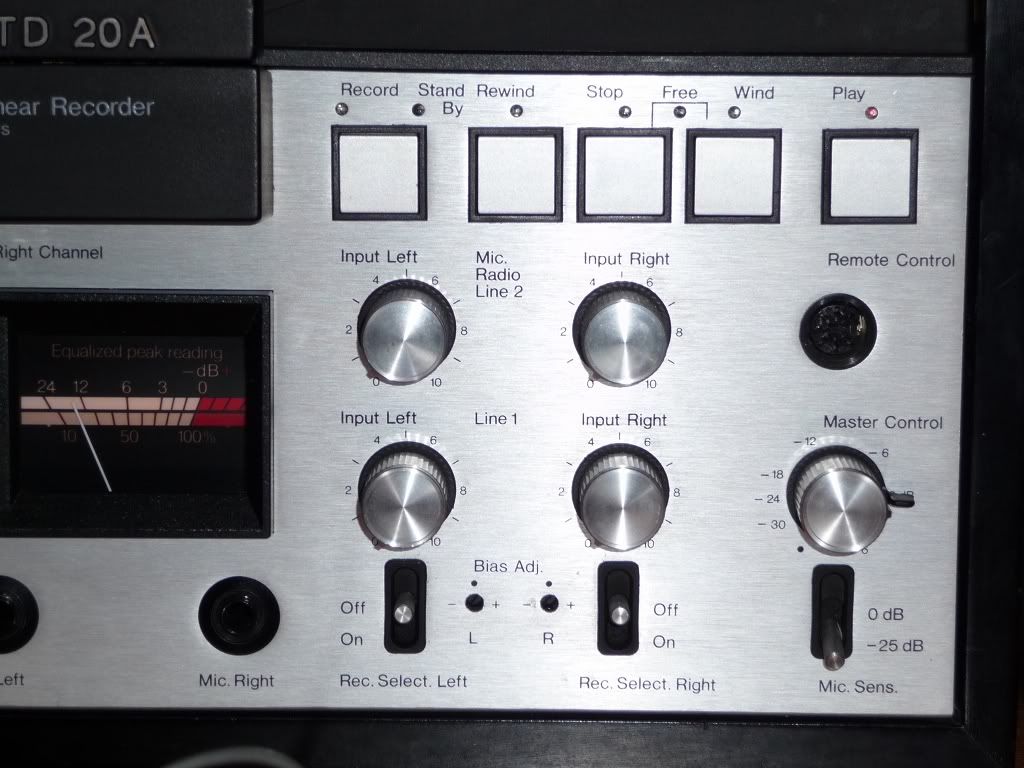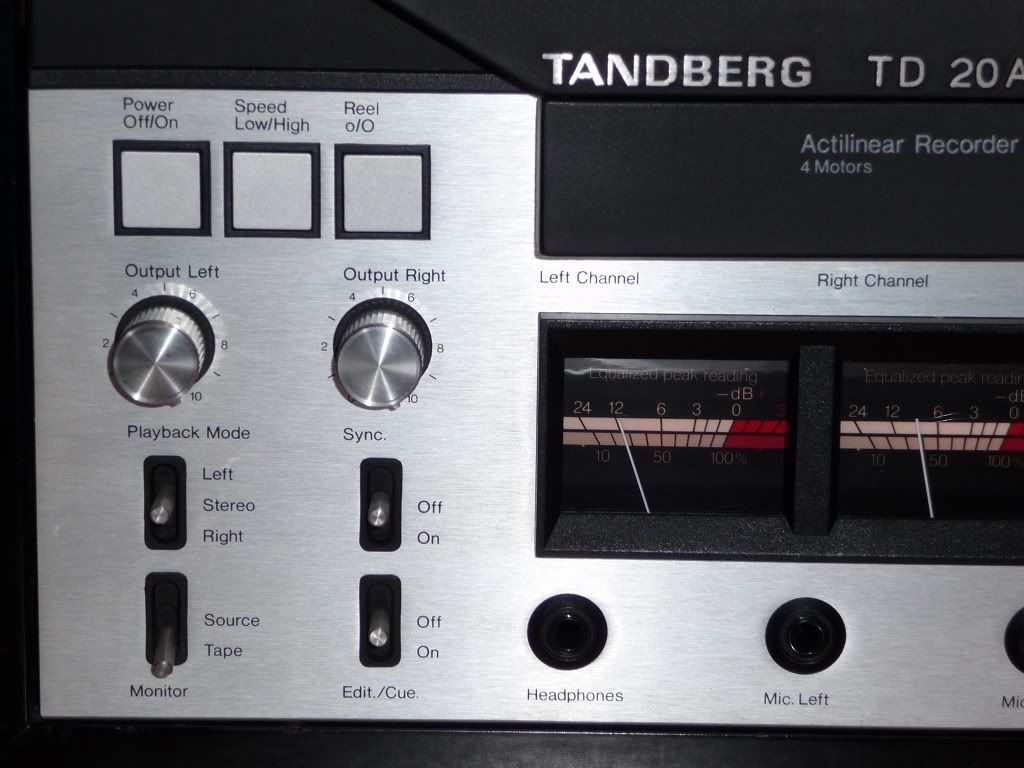Doing a test with a piece of Maxell UD tape recorded very hot played back at 19 cms/7.5 ips in the Uher 4400 Report Monitor plugged by the DIN output socket to my main stereo system. It sounds really good even with those levels.
Showing posts with label vid. Show all posts
Showing posts with label vid. Show all posts
Sunday, April 12, 2009
Friday, March 13, 2009
Saturday, February 7, 2009
VID: Akai GX-77
A close view to the singular Akai GX-77, a six heads machine with quick reverse function thanks to a dual capstan mechanism that spins in opposite directions and where only one pinch roller is used in each way, not both.
This was also the unique reel to reel deck that uses a very curious mechanism to place the tape in the correct heads path.
This was also the unique reel to reel deck that uses a very curious mechanism to place the tape in the correct heads path.
Sunday, October 26, 2008
VID: Grundig TS-1000
Here is another video of the Grundig TS-1000 available in high quality playing back "Galactica OST" at 19 cms / 7.5 ips. The tape is a AGFA 468 and the reels are metal Scotch painted in blue. They look really cool.
This unit is modified, you can read more about it clicking here.
This unit is modified, you can read more about it clicking here.
VID: Tandberg TD 20A
Here is another video available in high quality (originally shot in 720P) showing the Tandberg TD 20A playing back "Badly Drawn Boy" at 19 cms / 7.5 ips, this time with ReVox black metal NAB hub adapters.
Saturday, October 4, 2008
DES / VID: Tandberg TD 20A
This was the top of the line reel to reel deck made by Tandberg and can handle up to 10.5" reels . It was sold in two versions: 4 tracks and 2 tracks.
The 4 tracks version came with the standard domestic speeds: 9.5 cms / 3.75 ips and 19 cms / 7.5 ips, while the 2 tracks version came with the professional speeds: 19 cms / 7.5 ips and 38 cms / 15 ips.

Instead of the typical 3 motor design, this deck has 4 motors: one per each reel, one for the capstan and the last one for pinch roller engage. I think this deck was the only one made with this feature instead of the most typical design by solenoid.
But there are more odd things. For example, this deck doesn't have a PAUSE button. It's rare, but I think the explanation is the system used to engage the pinch roller.
Other odd is that isn't neccesary to press the record and play buttons at the same time, it's only needed to press the record button and the deck goes into the recording mode if at least one of the record switches are selected. When a record switch is on, the "stand by" led lights.
All transport functions are led lighted, even the "stop" and all leds are red.

There's one feature that it's curious: the "free" mode. When "stop" and "wind" buttons are pressed at the same time, the led with the "free" function lights. In that mode the brakes are released and both reels can be manipulated by hand without any friction.
If the "edit / cue" switch is on, the sound can be heared while the reels are manipulated by hand. To end the free mode, just press "stop" and the deck will tight the tape.

Bias adjustment can be done individually per each channel with two pots that are in the front face of the deck and there are individual pots for the input signals per channel (line 1 and line 2 / mic), mic attenuator and output signal.
And here is the Tandberg TD 20A in action:
The 4 tracks version came with the standard domestic speeds: 9.5 cms / 3.75 ips and 19 cms / 7.5 ips, while the 2 tracks version came with the professional speeds: 19 cms / 7.5 ips and 38 cms / 15 ips.

Instead of the typical 3 motor design, this deck has 4 motors: one per each reel, one for the capstan and the last one for pinch roller engage. I think this deck was the only one made with this feature instead of the most typical design by solenoid.
But there are more odd things. For example, this deck doesn't have a PAUSE button. It's rare, but I think the explanation is the system used to engage the pinch roller.
Other odd is that isn't neccesary to press the record and play buttons at the same time, it's only needed to press the record button and the deck goes into the recording mode if at least one of the record switches are selected. When a record switch is on, the "stand by" led lights.
All transport functions are led lighted, even the "stop" and all leds are red.

There's one feature that it's curious: the "free" mode. When "stop" and "wind" buttons are pressed at the same time, the led with the "free" function lights. In that mode the brakes are released and both reels can be manipulated by hand without any friction.
If the "edit / cue" switch is on, the sound can be heared while the reels are manipulated by hand. To end the free mode, just press "stop" and the deck will tight the tape.

Bias adjustment can be done individually per each channel with two pots that are in the front face of the deck and there are individual pots for the input signals per channel (line 1 and line 2 / mic), mic attenuator and output signal.
And here is the Tandberg TD 20A in action:
But, how is the 4th motor? how does it work exactly?. Look:
Monday, September 29, 2008
VID: Teac X-2000R inside
As I explained in the previous entry, I had to fix a tension arm problem with my Teac X-2000R, so after fixing it, I shot this video showing some inside views of the deck and how the capstan belt changes its position depending on which play direction is selected.
This happens because the capstan wheels have two parts, one with a diameter bigger than the other, so that when the forward direction is selected, the belt accomodates the position where the right capstan wheel spins a little faster than the left one, and the opposite, when the reverse direction is selected, the left capstan wheel spins a little faster than the right capstan wheel.
This happens because the capstan wheels have two parts, one with a diameter bigger than the other, so that when the forward direction is selected, the belt accomodates the position where the right capstan wheel spins a little faster than the left one, and the opposite, when the reverse direction is selected, the left capstan wheel spins a little faster than the right capstan wheel.
VID / REP: Teac X-2000R tension arms
Although my Teac X-2000R was almost mint, from the first moment the tension arms fluctuated when it was in play mode, both forward or reverse.
I swapped both tension arms guide rollers but the problem persisted.
I swapped both tension arms guide rollers but the problem persisted.
I opened the deck trying to figure out which was the problem. The auto-tension system is basically the same as the one found in the Grundig TS-1000. Each tension arm has a small plate attached in the inside and passes near a photodetector so that when the tension arm is in the lower position, the motor power goes up, and when the arm goes to a higher position, the tension applied to the motor goes down.
Here is a video shot from the inside of the machine:
Here is a video shot from the inside of the machine:
I tried to adjust the position of the photodetectors and even the trimmers that adjust the tension, but no luck, the problem still happening.
The tension arm axis is a screw that has springs. I realized that when I manipulated the screw, the height position of the tension arm varied. I adjusted this screw with the machine in play mode with a tape threaded so that I can watch the results in real time. I minimal adjustement was needed to watch the tension arm stops its oscillation.
In appearance, this was a rare failure, because most times whis happen is caused by old motors and/or poor lubricated rollers and arms, but in this case, both rollers are in perfect shape and the motors too.
Here is another video with the final result after the adjustement:
The tension arm axis is a screw that has springs. I realized that when I manipulated the screw, the height position of the tension arm varied. I adjusted this screw with the machine in play mode with a tape threaded so that I can watch the results in real time. I minimal adjustement was needed to watch the tension arm stops its oscillation.
In appearance, this was a rare failure, because most times whis happen is caused by old motors and/or poor lubricated rollers and arms, but in this case, both rollers are in perfect shape and the motors too.
Here is another video with the final result after the adjustement:
Saturday, September 27, 2008
VID: Pioneer RT-1020H spinning at 15 ips
This deck eat tape very fast when runs at 38 cms / 15 ips, but spins really fast when it's used 7" reels.
In the video can be also watched all the buttons and lettering in detail.
Sunday, September 21, 2008
VID / TIP: Trashing a sticky tape
If you have bought a tape and resulted to be sticky, or a tape that you already had and is completly useless for you once you have made a copy of the content, maybe you have asked yourself how to remove the tape but keeping the reel for future use as take up reel or to be fulled with other tape.
The first step is to be sure that your tape has the sticky shed syndrome. I usually do this method:
Once is threaded by the tape path, press FF and if you note than after one minute, it goes slow, press RWD. If the tape travels very slow or even can't travel, then is a sticky tape:
Well, now how to do with the tape to trash it fast and keep the reel without having as a result a never ending spaguetti tape incident:
I use a NAB hub without flanges, just the hub, but to get at least the correct aligment position as if were with a flange, I use a CD as a separator.
Easy and fast.
Easy and fast.
VID: Pioneer RT-909 inside
Today I've had to open the deck to make some mechanical adjustements, so I shot this video where is shown both external and internal parts of it in detail together with all transport functions from both points of view.
Saturday, September 20, 2008
VID: Pioneer RT-707 playing Iron Maiden
Just another video showing a Pioneer RT-707spinning. Since I'm doing the videos with a photo camera and sometimes with a webcam, the sound is really bad, but at this time I'm unable to copy from the video camera to the computer, so until better news, both video and audio quality won't be as good as in the first videos, but I think the top quality is not the goal when the videos will be watched in YouTube.
This time with two ReVox 7" metal reels, one in blue and one in gold, spinning at 19cm/s - 7.5 ips that contains close shots so that every detail can be watched.
I wish you like and enjoy it.
This time with two ReVox 7" metal reels, one in blue and one in gold, spinning at 19cm/s - 7.5 ips that contains close shots so that every detail can be watched.
I wish you like and enjoy it.
Sunday, September 14, 2008
VID: Using a bulk eraser
Sometime ago I placed an entry doing a description of the Teac E-2 bulk eraser. Now I've shot a video showing how to use it. Normally I use the bulk eraser when I want to recycle an already recorded tape to ensure that the new recording will no have any rest of the old recording due to alingment issues or any other issue.
Another reason to use the bulk eraser is to try to restore the tape to the a like virgin state, erasing also any hiss that was in the tape.
Another reason to use the bulk eraser is to try to restore the tape to the a like virgin state, erasing also any hiss that was in the tape.
Thursday, August 21, 2008
VID: Pioneer RT-909 playing "Doctor Who"
In this video, the Pioneer RT-909 is playing back one of the most famous TV themes of all times: "Doctor Who", originally composed by Delia Derbyshire.
The tape was recorded at 7.5 ips - 19 cm/s loaded into one the smallest reel I have and uses the original NAB hub adaptors and the original metal take-up reel.
The tape was recorded at 7.5 ips - 19 cm/s loaded into one the smallest reel I have and uses the original NAB hub adaptors and the original metal take-up reel.
Thursday, August 14, 2008
VID: Pioneer RT-707 playing Jazz
This was probably the best of the 7" reel to reel decks ever made, built like a tank.
It has three motors (all direct drive), four heads (erase, record and forward and reverse playback), two speeds (7.5 and 3.75 ips / 19 and 9.5 cms) and is autoreverse in playback mode.
The unique belt the machine has inside is the used for the counter. All transport functions are activated by solenoids and has big and real reading VU meters.
The unique belt the machine has inside is the used for the counter. All transport functions are activated by solenoids and has big and real reading VU meters.
Has a switch for bias setting (STD and LH) and another for EQ setting (STD and LH), independent record channel modes, pitch control, autorepeat function and line and mic input knobs with mix signal function. In the backside, it has independent output volume knobs.
Tuesday, August 12, 2008
VID: Teac X-2000R transport functions
The Teac X-2000R was the top of the line of the reel to reel tape recorders made by Teac and dedicated to the HIFI enthusiasts.
It has a computerized transport control which allows to do some functions like make a cue point, go to the cue point, go to zero and the repeat function.
A cue point is a virtual mark in the tape. The repeat function works between the zero and the cue point. The deck goes from the zero point to the cue point and after that, it rewinds and starts from the zero point again and again and again until repeat button is depressed.
In the next video is shown how the repeat function works, but also the pitch control, the speed change and the direction change.
Sunday, August 3, 2008
VID: Pioneer RT-1020H
Recording from CD in first place and playing back later. The sound is not good and the image is mid quality because all was captured using a webcam.
Cool blue reels spinning!
Cool blue reels spinning!
Sunday, June 1, 2008
VID: Pioneer RT-909
In this video, the Pioneer RT-909 is playing back a tape recorded at 7.5 ips - 19 cm/s loaded into big reels and uses ReVox metal blue NAB hub adaptors.
VID: Akai GX-77
The GX-77 was the last model made by Akai. It's the younger brother of the GX-747.
It's a three motors machine, two speeds (3.75 ips - 9.5 cm/s and 7.5 ips - 19 cm/s), full reverse with 6 heads and ca handle up to 7" reels.
Can use "EE" tape and has external bias fine adjustement. The difference with any other reel to reel deck is the exclusive system to load the tape, which uses a roller to make the tape go against the heads.
VID: Grundig TK-146
I have recently fixed this beauty. It looks like new has more than 40 years. This one was the first Grundig machine made with transistors instead of tubes. It's a 4 tracks 1 channel mono, single speed (9.5 cm/s - 3.75 ips) and single motor. Has built-in amp and speaker. It can handle up to 5" 3/4 - 15 cms. reels. Although is a mono machine, can reproduce two channels at a time.
I recorded a stereo tape in a Pioneer RT-909 and here is the result:
I recorded a stereo tape in a Pioneer RT-909 and here is the result:
Subscribe to:
Posts (Atom)




